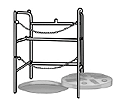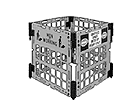
PREVENTING FALLS ASSOCIATED WITH THE E/E BAY MAIN DECK ACCESS PANEL
Accidents involving the E/E bay main deck access panel can be prevented by following correct procedures. According to the Boeing airplane maintenance manuals (AMM), the E/E bay main deck access panel is to be used for “access to the E/E bay while in flight.” This access is potentially needed for extreme emergencies, such as by the cabin crew to fight an E/E bay fire. During hangar maintenance, the internal access panel may be used by operators to accommodate extensive airplane maintenance or modification activity. However, the internal access panel was never intended for the purpose of line maintenance in which flight crew, cabin crew, catering personnel, and passengers might be endangered. The Boeing AMM maintenance procedure does not direct a mechanic into the E/E bay using the internal main deck access panel. When entry to the E/E bay is needed, the AMM maintenance procedure directs the mechanic to enter the E/E bay via the external access door.
To help prevent accidents and injuries related to this panel, all 777s now being delivered have a hinged, self-closing access panel, and all 747s now being delivered have a safety net attached. For retrofitting purposes, all three airplane models have a hinged, self-closing access panel available, and the 747 and 767 models have a safety net available. Since 1982, Boeing has released a number of service bulletins related to methods available on the various models to block access to this panel. (Please refer to service bulletins Nos. 747-53-2434, 767-53-0092, and 777-53-0021.)
If an operator elects not to install a self-closing access panel or safety net, Boeing recommends the installation of an E/E access opening safety guard around the exposed opening in the floor or the installation of a safety barrier in the cabin across the access door panel whenever the panel is removed. Examples of safety barriers are shown in figures 1 and 2.
|
Figure 1 Folding manhole guard safeguards open manholes or areas up to 33 inches square. This 42-inch-high guard folds to 33-by-4 inches for easy transport and compact storage. It has a strong, tubular steel frame with a yellow powder-coated finish. |
 |
Figure 2 Highly visible, this four-panel barrier alerts everyone in the area to the presence of a work zone. It features durable, lightweight orange polypropylene panels. Each barrier panel is 30 inches high by 34½ inches wide. Panels have quick-release snap hinges for easy setup. Two panels can be used together as an A-frame barricade or two or more barriers can be joined together to create a larger work zone. |
 |
During line maintenance on the 747, 767, and 777 airplanes, Boeing recommends the use of the external access door at the bottom of the fuselage instead of the internal access door (i.e., E/E bay main deck access panel) in order to gain access to the electrical equipment bay.
BLOCKING OPEN CABIN AND CARGO DOORS
Passenger and cargo doors should be closed when access to the airplane cabin or cargo compartment is no longer needed. Many airlines state this explicitly in their policies and procedures.
On occasions when doors are left open deliberately, such as to air out an airplane during cleaning, steps should be taken to block the door. Some operators use a simple strap to provide a visual signal that a door is open. However, the strap is not designed to stop a fall. Boeing recommends the use of a net any time a passenger or cargo door is left open and unprotected. This recommendation is also included in the 27th edition of the International Air Transport Association's Airport Handling Manual, which became effective Jan. 1, 2007. Boeing ground-support-equipment safety nets are available for use in cases in which the passenger door must be open or whenever a passenger door is being replaced.
FLOOR HATCHES AND PANELS ON DC/MD-10, MD-11 AIRPLANES
Operators have reported instances of flight attendants inadvertently stepping into an open and unguarded floor hatch. In response, warning placards have been installed adjacent to main deck floor access hatches. If a lower galley is installed, these placards are located near the lower galley escape hatch, as well as near the center accessory compartment access panel.
Boeing recommends that operators further protect the safety of their personnel by erecting a barricade, such as those shown in figures 1 and 2 around any open floor access hatch or panel.
THE ROLE OF AIRLINE POLICIES
If operators elect not to purchase and install the recommended hinged access panels or safety nets, or choose not to use the recommended safety barriers, they should use local procedures to provide for the safety of the flight attendants and servicing personnel. These procedures include specific policies dictating how open floor panels, hatches, and doors should be protected. For example, an employee can be assigned to guard the panel or door while it is open.
SUMMARY
Open doors, access panels, and hatches can present safety hazards, but falls through them can be prevented by proper and consistent use of barriers and following airline policies and procedures.
For more information, please contact William L. Rankin at william.l.rankin@boeing.com or William R. Carlyon at william.r.carlyon@boeing.com.

